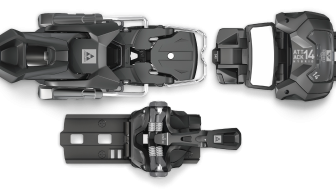I watched Maria and Bob pore over a map of the Icefields Parkway on the hostel wall at Lake Louise with some trepidation. They were committing the topography of the Rocky Mountains to “memory” and I was right to be nervous. Once they memorized the map off we went to the pub for a few brews, and my worries were quickly forgotten, for a while.
In the morning, we loaded skis onto the roof of the truck and hastily threw our gear in the back, bound for a hostel on the Parkway. In our haste, we were totally unaware that some of the bags we were loading weren’t our own.
“Whose towel is this,” I asked while unpacking my bags at the next hostel. My question was met with blank stares and mutual realization that we had to drive back to Lake Louise to return the bags. At that moment, I should have known that things could only get worse.
We planned to take it easy the next day (following the baggage hustle the night before) with a short ski tour to Crowsfoot Pass. This was mid-February and a deep Artic high pressure ridge had formed over the area bringing deep blue skies, bright sunshine and wickedly cold temperatures. “Cold enough to freeze the balls off a brass monkey,” Bob muttered as we skinned toward the pass. I looked over to the slanted rock of Dolomite Peak to the east, its angled slopes covered in silver snow, and I naively thought about enjoying a nice early supper while relaxing with a glass of wine in the hostel that evening.
At the top of the pass, Maria confidently stated that she remembered the map well, and that all we had to do was ski over the pass, down to Hector Lake, cross the lake and climb back to the highway for a nice circle tour. Bob concurred.
I pointed out that we had neither a map nor a compass, a fact my partners ignored as a detail considered not a priority, and perhaps, even an impediment to adventure.
Rather than split the group, I followed my partners down the slope toward the lake. Neither had memorized the contour lines (an adventure requirement), and the gradual grade quickly became a steep-sided gully with trees so tight I had to turn my shoulders to push through the gaps. The masochistic form of tree skiing led us onto a snow-covered riverbed, which then led us farther up the lake from where the map memorizers intended to be.
It was dusk when we arrived at the lake. Before us, the cold shadow of grey and white snow stretched so far in the distance that it was difficult for my frozen eyes to focus on the far end. Still, it was flat, there were no trees to mangle us, and all we had to do was cross the lake to be at the truck and back for the dinner I had been dreaming of earlier.
But nothing is easy when it comes to an adventure.
When my skis met the lake surface, I found the snow had created an insulated layer of water above the ice. My skis penetrated through the snow to a watery layer, emerged and froze solid in the night air. We shuffled slowly across the lake with blocks of ice strapped to our feet like the last survivors of some futuristic, frozen-world apocalypse. Dusk had turned quickly to a moonless night and the temperature dropped to around -22 Celcius (that’s metric for very cold). For three hours we pushed the dead weight of our skis, stopping occasionally to chip off ice but only to have it reform on the next step.
At the end of the lake, we found that the road wasn’t even there, and that we needed to skin through the forest. But everything—our skins and even emergency duct tape—were too cold to stick to our skis. For another hour, with half-sticking skins, we pushed on until we crawled over the guardrail onto a deserted road with our truck several kilometers away.
The Icefields Parkway in the early hours of a February Sunday morning is really deserted, therefore, using the traditional hitchhiker’s technique, we pushed the only women in our group forward to ensure any vehicle that did appear would stop. Eventually, we were saved by a couple redneck sledders and their giant, deep-throated truck on the way back to Alberta. None of us spoke a bad word about snowmobilers for at least the rest of the week.
The next day, at breakfast, the wayward skiers were the talk of the hostel. “Did ya hear about them skiers who got themselves lost?” said a young guy gesticulating toward me with a piece of pancake on the end of his fork. “Didn’t take a map or anything. It’s inconsiderate…it’s terrible”. I nodded and agreed with my fellow breakfaster. “Yep,” I said. “Those types should never be allowed in the backcountry.”
Tell us your story, keep it to 700 words and send it to sean@backcountrymagazine.com subject titled “Backstory” for a chance to be published.










Great story, felt part of the adventure